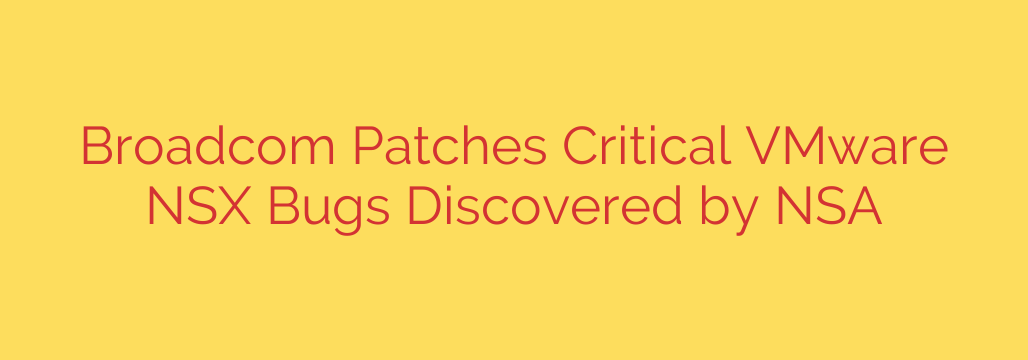
Urgent Security Alert: Broadcom Patches Critical VMware NSX Vulnerabilities
Broadcom has released critical security patches for its VMware NSX network virtualization platform, addressing a series of severe vulnerabilities. These flaws could allow attackers to bypass security controls and gain complete administrative control over affected systems. Administrators are strongly urged to apply these updates immediately to protect their network infrastructure from potential compromise.
The vulnerabilities, discovered and reported by the National Security Agency (NSA), affect multiple versions of VMware NSX. Given the central role NSX plays in managing and securing virtualized network environments, exploiting these flaws could have devastating consequences, including data breaches, lateral movement across a network, and full system takeovers.
Understanding the Critical Vulnerabilities
Four key vulnerabilities have been addressed in this latest security update. Each poses a significant threat to enterprise environments relying on VMware for their network infrastructure.
CVE-2024-22252 (CVSS score: 9.8 – Critical): This is a highly severe privilege escalation vulnerability. A malicious actor with local access to an NSX appliance could exploit this flaw to elevate their privileges to ‘root,’ effectively gaining complete control over the system. This is the most critical vulnerability in the set.
CVE-2024-22253 (CVSS score: 7.8 – High): Also a privilege escalation vulnerability, this flaw allows an attacker with root access on a host to escalate their privileges within the NSX-T environment. This could enable them to move from a compromised host to control the broader network fabric.
CVE-2024-22254 (CVSS score: 8.0 – High): This is a URL-parsing vulnerability that could lead to an authentication bypass. An attacker could exploit this issue by manipulating URL-encoded characters to bypass token validation, potentially gaining unauthorized access to system APIs and services.
CVE-2024-22255 (CVSS score: 7.2 – High): This vulnerability allows for privilege escalation through the mishandling of symbolic links. An attacker with local access could exploit this flaw to elevate their permissions, further compromising the integrity of the NSX appliance.
The Impact: Why You Must Act Now
VMware NSX is a foundational component of modern software-defined data centers (SDDCs). It controls traffic flow, enforces security policies, and provides micro-segmentation to isolate workloads. A compromise of the NSX platform could lead to a catastrophic security failure.
An attacker successfully exploiting these vulnerabilities could:
- Disable or alter security policies, rendering firewalls and other protections useless.
- Gain unrestricted access to sensitive network traffic flowing through the virtualized environment.
- Move laterally across the network to compromise other critical servers and applications.
- Deploy ransomware or other malware throughout the entire infrastructure.
Because NSX manages the core network fabric, its compromise effectively hands the keys to the kingdom to an attacker, making detection and remediation extremely difficult.
Actionable Steps: How to Protect Your Systems
To mitigate these critical risks, immediate action is required. There are no known workarounds for these vulnerabilities, making the installation of patches the only effective solution.
1. Identify Affected Versions:
The vulnerabilities impact the following product versions:
- VMware NSX-T Data Center versions 3.x and 4.x
- VMware Cloud Foundation (VCF) versions 4.x and 5.x
2. Apply the Patches Immediately:
Broadcom has released updated versions to address these flaws. Administrators should upgrade to the following or newer versions as soon as possible:
- For NSX 4.x users, upgrade to version 4.1.2.2.
- For NSX 3.x users, upgrade to version 3.2.3.3.
3. Review Access Controls:
As a best practice, review and enforce the principle of least privilege for all accounts with access to your NSX management interface and appliances. Limiting local access can reduce the attack surface for vulnerabilities like CVE-2024-22252 and CVE-2024-22255.
4. Monitor for Suspicious Activity:
Closely monitor NSX logs for any unusual or unauthorized configuration changes, API calls, or access patterns. This can help detect potential indicators of compromise, especially if patching is delayed for any reason.
In today’s threat landscape, proactive patching is a non-negotiable part of a robust cybersecurity strategy. The severity of these vulnerabilities, combined with their discovery by a national security agency, underscores the urgent need for all VMware NSX administrators to take immediate and decisive action.
Source: https://www.bleepingcomputer.com/news/security/broadcom-fixes-high-severity-vmware-nsx-bugs-reported-by-nsa/








